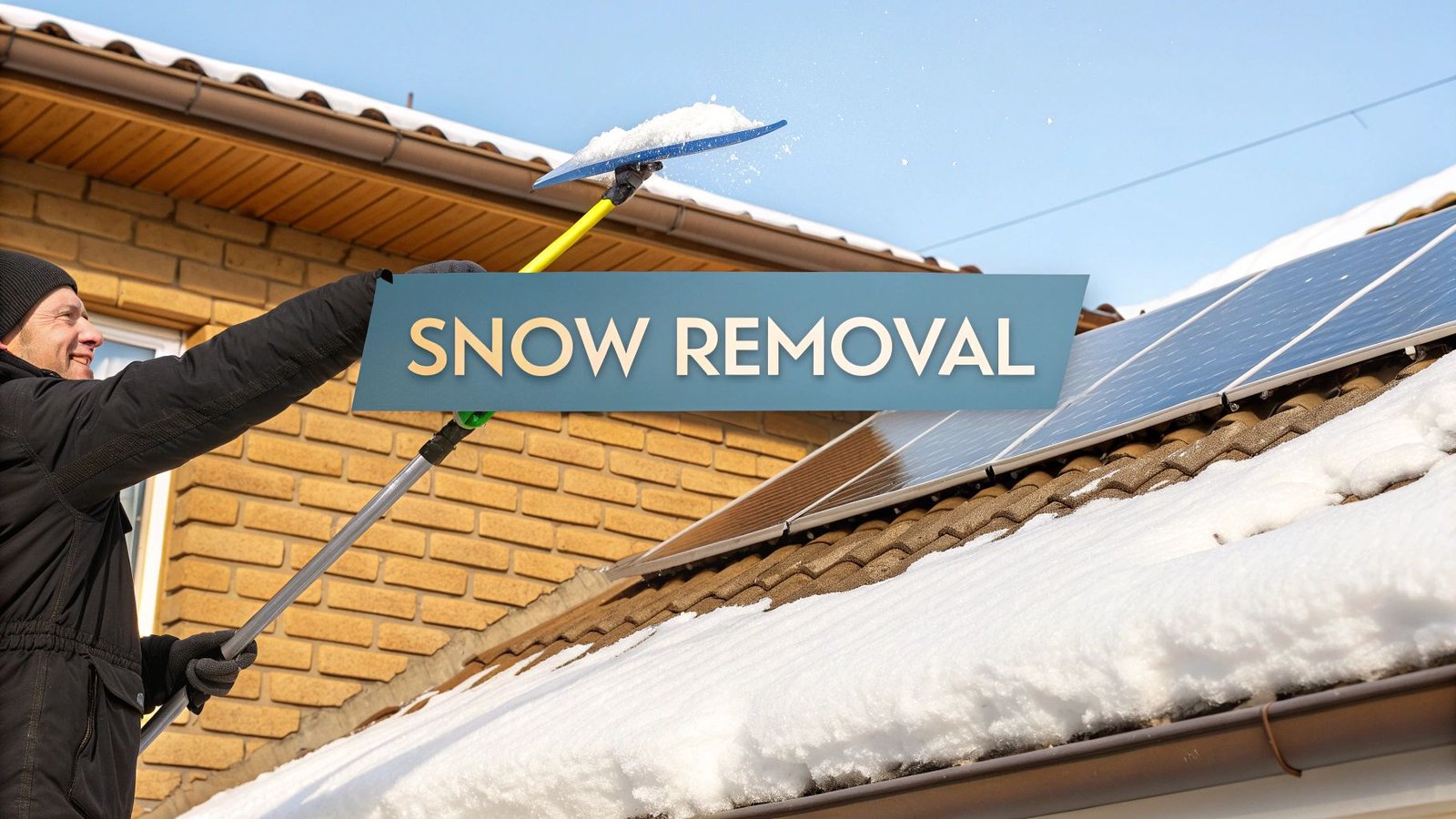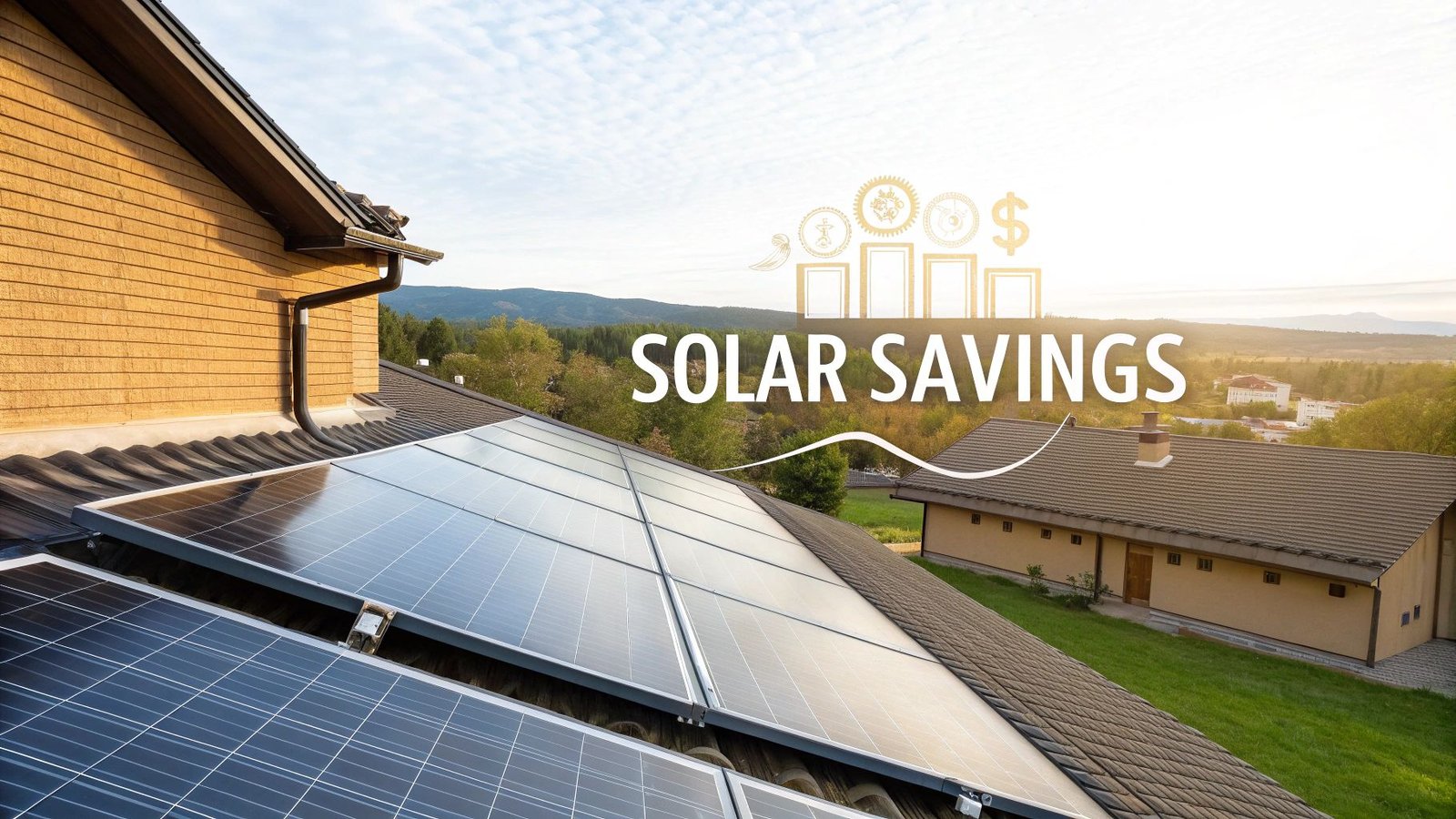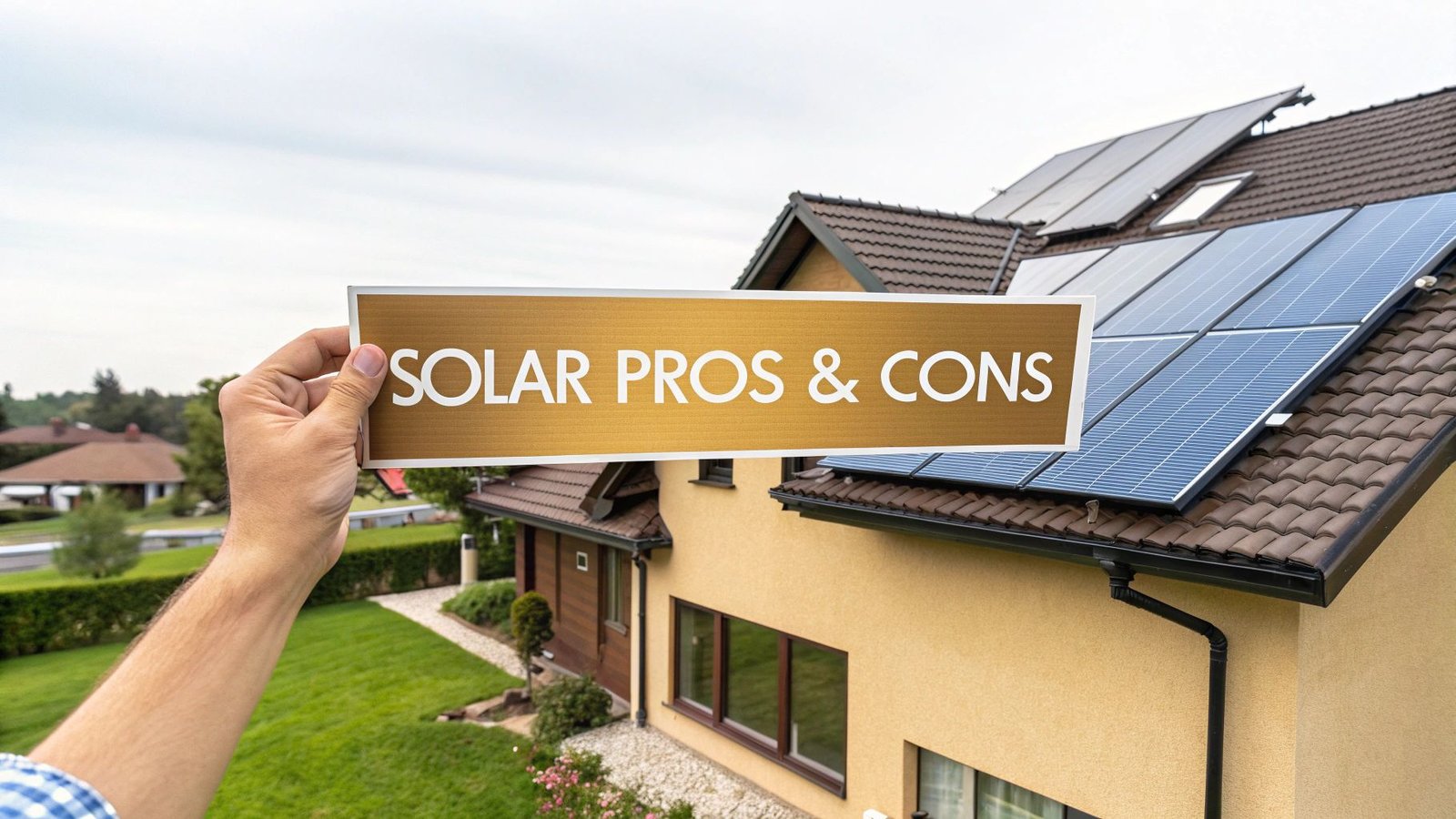Cuando un manto de nieve cubre el tejado, siempre surge la pregunta de si hay que quitarla de los paneles solares. ¿La respuesta? Depende. Una ligera capa de polvo probablemente se derretirá por sí sola, pero si se trata de nieve abundante y persistente, la producción de energía puede caer en picado, por lo que la limpieza manual es una idea bastante sensata en algunos climas.
Despejar o no despejar: la cuestión de los paneles solares en invierno
Decidir si hay que quitar la nieve de los paneles solares es un dilema invernal clásico para los propietarios de viviendas en regiones nevadas. Sinceramente, no hay una respuesta correcta para todo el mundo. La decisión depende de varios factores: las condiciones meteorológicas locales, el ángulo de los paneles y la cantidad de energía solar que necesites en ese momento.
Una nevada ligera y esponjosa, por ejemplo, suele ser lo bastante translúcida como para que se cuele algo de luz solar. Normalmente se derrite o se desliza en cuanto sale el sol. Pero cuando caen varios centímetros de nieve espesa y húmeda, la producción puede detenerse por completo. De repente, su inversión en alta tecnología se queda ahí sin hacer nada. Es entonces cuando hay que pensar en la compensación económica.
Sopesar el esfuerzo y la recompensa
Hay que preguntarse: ¿merece la pena el tiempo, el esfuerzo y el riesgo potencial que supone la energía que voy a ganar limpiando los paneles? Piénselo: para una familia de un lugar como Colorado, una semana con los paneles cubiertos de nieve en diciembre puede suponer un aumento real de la factura de la luz. Si comparamos las facturas de electricidad de un mes con nieve con las de un mes sin nieve, veremos el impacto que tiene.
El impacto de la nieve es importante, pero se puede controlar. Hemos visto estudios que demuestran hasta qué punto la nieve puede reducir la producción solar en invierno. En estudio sobre el rendimiento solar en invierno en un lugar de alta latitud encontró una diferencia de producción anual de 950 kWh entre dos años diferentes. ¿El truco? Los meses de invierno fueron responsables de 65% de esa variaciónaunque sólo sean una pequeña parte del tiempo total de producción del año.
pie
título Desviación de la producción anual debida a la nieve invernal
"Meses de invierno" : 65
"Otros meses" : 35
Decidir cuándo actuar puede ser complicado, así que aquí tienes una guía de referencia rápida que te ayudará a tomar la decisión.
Matriz de decisiones: Cuándo limpiar los paneles solares
| Nivel de nieve | Ángulo de inclinación del panel | Previsión | Acción recomendada |
|---|---|---|---|
| Polvo ligero ( < 2 pulgadas) | 35° o más | Soleado, sobre cero | Espera. Es probable que la nieve se derrita o se deslice por sí sola en un día. |
| Polvo ligero ( < 2 pulgadas) | Menos de 35 | Nublado, bajo cero | Considera despejar. Puede que se mantenga y afecte ligeramente a la producción. |
| Nieve moderada (2-6 pulgadas) | 35° o más | Hechizos de sol | Espere entre 24 y 48 horas. El ángulo pronunciado y el sol deberían hacer la mayor parte del trabajo. |
| Nieve moderada (2-6 pulgadas) | Menos de 35 | Continuación del frío/nubes | Despeja con seguridad. Esta cantidad bloqueará significativamente la producción y no se derretirá rápidamente. |
| Nieve intensa ( > 6 pulgadas) | Cualquier ángulo | Cualquier previsión | Despeja con seguridad. Este nivel de acumulación detendrá toda la producción y puede suponer un riesgo para el peso. |
| Hielo / Nieve helada | Cualquier ángulo | Cualquier previsión | NO limpiar. Espere a que se derrita. Intentar quitar el hielo puede dañar fácilmente los paneles. |
Esta tabla debería darte un buen punto de partida. Cuanto más inclinados sean los paneles y más soleado sea el pronóstico, más probabilidades tendrás de dejar que la naturaleza se encargue de todo.
Este árbol de decisiones le ofrece una excelente visión para determinar la mejor forma de actuar en función de la inclinación de su panel y de la profundidad de la nieve.

Como puede ver, un ángulo de panel más pronunciado es su mejor amigo cuando se trata de nieve. A menudo hace que la retirada manual sea completamente innecesaria.
Lo más importante: Dejar que la nieve se derrita por sí sola es siempre el camino más seguro. Pero recuerda que una capa de nieve prolongada se traduce directamente en una pérdida de generación de energía. La decisión de intervenir debe basarse en la seguridad, la cantidad de nieve y el grado de dependencia de la energía solar durante el invierno.
El equipo adecuado para retirar la nieve con seguridad
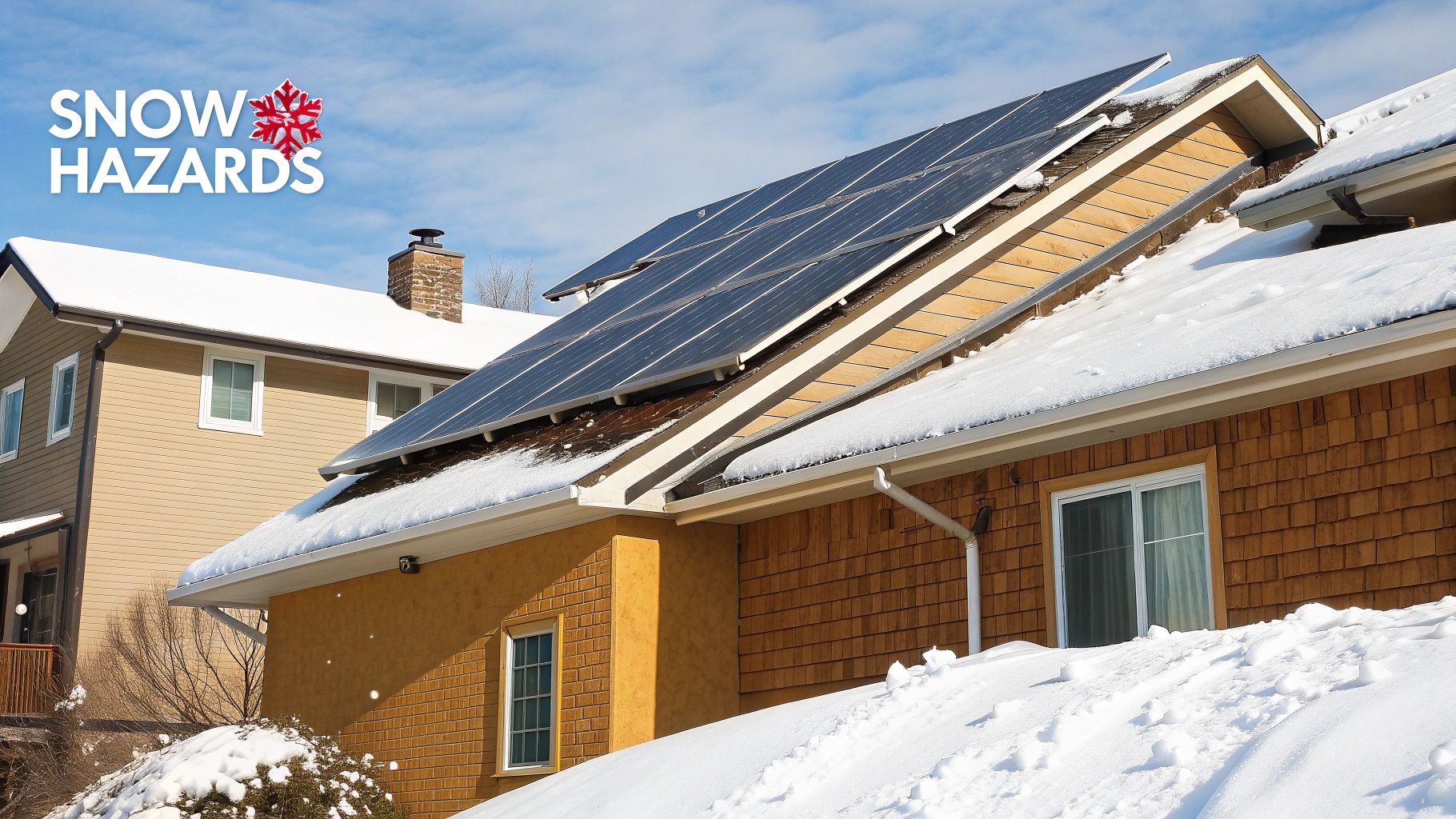
Antes de pensar siquiera en salir a despejar tu terreno cubierto de nieve, hablemos del equipo. Disponer de las herramientas adecuadas no es sólo una sugerencia; es la parte más importante para realizar este trabajo con seguridad y eficacia.
Coger la herramienta equivocada es la forma más rápida de dañar los paneles o, peor aún, de hacerse daño. Un rastrillo de jardín normal o una pala de nieve con borde metálico están totalmente prohibidos. Pueden rayar, astillar o incluso romper el cristal de los paneles, lo que anularía la garantía y reduciría de forma permanente la producción de energía.
Elección de la herramienta principal
La herramienta más importante que necesitará es un rastrillo de nieve con panel solar. No es un rastrillo de tejado corriente. Se ha diseñado específicamente para este trabajo, con un cabezal suave y no abrasivo, normalmente de espuma o con una hoja de goma en forma de rasqueta. Esto es fundamental para proteger el revestimiento antirreflectante de los paneles.
Asegúrese de que tiene una pértiga larga y telescópica. Esa extensión es lo que le permite despejar los paneles mientras sus pies están plantados de forma segura en el suelo, que siempre debe ser su objetivo. He visto rastrillos más baratos con cabezales de plástico que se vuelven quebradizos con el frío y se rompen a mitad del trabajo. Merece la pena gastar un poco más en una herramienta de calidad que dure.
Consejo de experto: Piense en un buen rastrillo para paneles solares como un seguro para su sistema. Es lo único que se interpone entre una limpieza rápida y segura de la nieve y una factura de reparación enorme porque usaste una pala.
Equipo de seguridad esencial
Una vez que tengas el rastrillo, no te olvides de tu propia seguridad. Trabajar en condiciones de hielo y nieve es arriesgado, aunque permanezcas en el suelo.
Aquí tienes una lista rápida de lo que deberías tener preparado:
- Botas de invierno de alta tracción: Nunca se sabe dónde se esconde una placa de hielo. Un agarre sólido es tu mejor defensa contra una caída desagradable.
- Una escalera robusta: Si no tienes más remedio que utilizar una escalera para conseguir un mejor ángulo en un tejado de poca inclinación, asegúrate de que esté en un terreno sólido y nivelado. Y tenga siempre un observador sujetando la base.
- Arnés de seguridad: Si su tejado es lo suficientemente inclinado como para que incluso pensando de subirse a él, necesita un arnés. Francamente, esto es una gran señal de que es hora de llamar a los profesionales.
Si reúnes todo este equipo antes de que llegue la primera gran tormenta, estarás preparado cuando lo necesites. Se trata de protegerte a ti y a tu inversión solar.
Quitar la nieve de los paneles solares de forma segura y eficaz
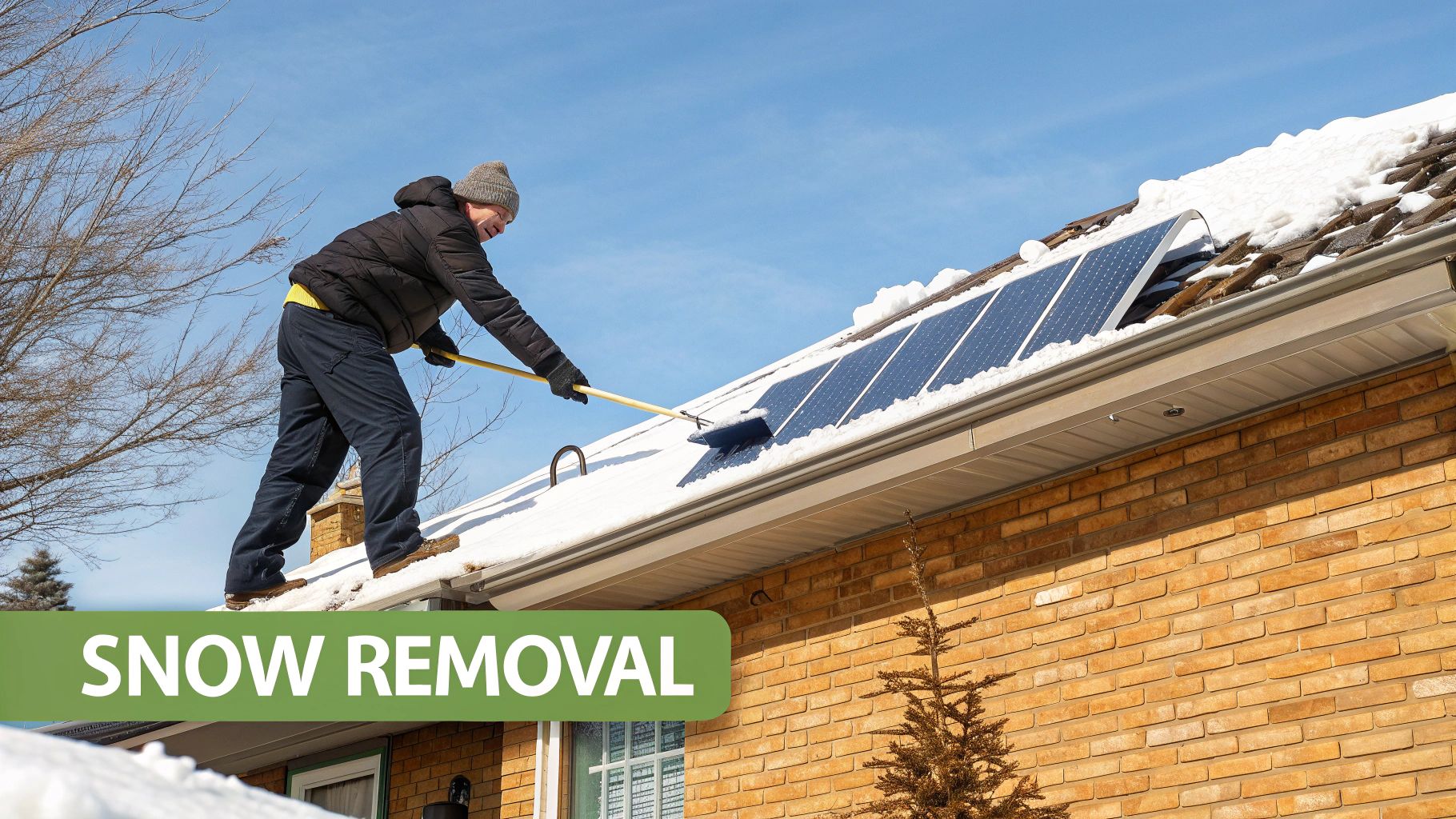
Muy bien, ya tienes las herramientas adecuadas, así que vamos a limpiar la nieve. Hay una regla de oro que no puedo enfatizar lo suficiente: permanezca en el suelo siempre que sea posible. En serio, subirse a un tejado resbaladizo y cubierto de nieve es buscarse problemas, y para este trabajo casi nunca es necesario.
Antes de pensar siquiera en extender el rastrillo quitanieves, tómate un momento para mirar a tu alrededor desde un lugar seguro en el suelo. ¿Hay líneas eléctricas aéreas? ¿Hay zonas heladas justo donde caerá la nieve? ¿Hay algo con lo que puedas tropezar? Una rápida comprobación de la seguridad es el primer paso más inteligente que puedes dar.
Dominar la técnica del pull down
La mejor manera que he encontrado para limpiar paneles es un sencillo método de "tirar hacia abajo". Coge tu rastrillo solar de mango largo y coloca suavemente su suave cabeza en el punto más alto del panel que puedas alcanzar cómodamente. A continuación, tira de la nieve hacia abajo, guiándola desde el borde inferior del panel solar.
Es muy importante tirar sólo hacia abajo. Si intentas empujar la nieve hacia los lados o hacia arriba, corres el riesgo de calzarla bajo los marcos de los paneles. Con el tiempo, esto puede provocar la entrada de humedad y causar verdaderos daños. Deja que el peso de la herramienta haga el trabajo; no es necesario utilizar la fuerza bruta.
Si sus paneles están en el tejado de un segundo piso, se aplica la misma idea, sólo necesitará un rastrillo con una pértiga telescópica mucho más larga. Planta los pies con firmeza para tener una base estable que te permita un control total sin perder el equilibrio. Si te esfuerzas o simplemente no puedes alcanzar toda la superficie del panel desde el suelo, es el momento de parar.
Advertencia crítica: Hagas lo que hagas, nunca utilice agua caliente, sal o descongelantes químicos en sus paneles. Echar agua caliente sobre el cristal congelado puede provocar un choque térmico y crear pequeñas grietas que ni siquiera se ven. Los productos químicos son igual de perjudiciales: pueden corroer el marco y estropear el revestimiento antirreflectante, lo que perjudicará permanentemente el rendimiento del sistema.
Ya que hablamos de mantenimiento, recuerda que la rutina limpieza profesional de paneles solares es una forma estupenda de mantener su sistema en plena forma durante todo el año. Pero para la nieve de invierno, no todas las tácticas de retirada son iguales.
Comparación de los métodos de retirada de nieve
La elección de cómo despejar los paneles implica un equilibrio entre seguridad, coste y eficacia. He aquí un rápido desglose de los enfoques más comunes que he visto.
| Método | Riesgo para la seguridad | Riesgo de daños en los paneles | Eficacia | Lo mejor para |
|---|---|---|---|---|
| Rastrillo solar | Bajo | Bajo | Alta | La mayoría de las viviendas residenciales con baterías accesibles desde el suelo. |
| Esperando al sol | Ninguno | Ninguno | Moderado | Nieve ligera y esponjosa en paneles con una inclinación pronunciada. |
| Paneles calefactados | Ninguno | Bajo | Muy alta | Propietarios de viviendas en climas con mucha nieve; requiere una mayor inversión inicial. |
| Servicio profesional | Ninguno | Muy bajo | Muy alta | Techos altos o empinados, hielo pesado o cualquiera que prefiera no arriesgarse. |
En última instancia, el mejor método depende totalmente de su situación específica: su tejado, el tipo de nevada y su propio nivel de comodidad.
Cuándo llamar a un profesional
Conocer tus límites es la herramienta de seguridad más inteligente que tienes. Es hora de coger el teléfono y llamar a un profesional si:
- El tejado es demasiado alto para alcanzarlo con seguridad desde el suelo.
- Su tejado tiene una pendiente muy pronunciada.
- Los paneles están recubiertos de una gruesa y tenaz capa de hielo.
- Por la razón que sea, no te sientes seguro haciéndolo tú mismo.
Contratar a un profesional asegurado es una pequeña inversión para evitar una visita al hospital o una factura abultada por los paneles dañados. Cuidar adecuadamente de su sistema es una parte importante de una inversión a largo plazo. https://radiantenergysolar.com/solar-panel-optimization-2/y, a veces, lo más inteligente es dejar que se encargue un experto.
Errores comunes que pueden arruinar su inversión en energía solar
Conocer la forma correcta de quitar la nieve de los paneles es sólo la mitad de la batalla. Sinceramente, saber qué no es igual de importante, quizá incluso más. He visto a demasiados propietarios bienintencionados causar accidentalmente miles de dólares en daños porque tenían prisa y cogieron la herramienta equivocada. Un simple error puede destrozar los paneles, anular la garantía y arruinar el rendimiento del sistema.
¿El error más común? Utilizar la herramienta equivocada. Es muy tentador coger un rastrillo estándar, una pala metálica o incluso una escoba rígida. No lo haga. Estas cosas son demasiado abrasivas y rayarán absolutamente el cristal de sus paneles. Esos arañazos y microfisuras no son sólo estéticos, sino que dañan permanentemente el panel y reducen su eficacia.
Los peligros ocultos de los materiales abrasivos
Incluso cosas que parecen un atajo inteligente pueden ser increíblemente destructivas. He oído a gente pensar en utilizar sal gema o descongelantes químicos para derretir la nieve más rápido. Es una idea terrible. Estos productos químicos son corrosivos y corroen los marcos de aluminio y dañan el delicado revestimiento antirreflectante, crucial para maximizar la absorción de la luz solar.
gráfico TD
subgrafo NO USAR
A[Palas de metal] --> D{Panel de daño};
B[Sal de Roca / Descongeladores] --> D;
C[Escobas / Cepillos] --> D;
fin
D --> E[Arañazos y Microfisuras];
D --> F[Corrosión en los marcos];
D --> G[Garantía Anulada];
Permítanme darles un ejemplo real del que he oído hablar. Un propietario intentó utilizar un potente soplador de hojas para quitar nieve ligera y esponjosa. Parecía inteligente, ¿verdad? El problema era que el soplador también levantaba gravilla y pequeños restos del tejado, lo que provocaba un chorro de arena en los paneles. El daño fue inmediato e irreversible, y el descenso en la producción de energía fue significativo.
Sus paneles solares son una inversión duradera pero delicada. Utilizar cualquier otra herramienta que no sea suave y específica es como usar papel de lija para limpiar unas gafas: causa daños que no se pueden reparar.
Distribución desigual del peso y microfisuras
Otro error que la gente comete a menudo es cómo manipula la nieve que acaba de retirar. Amontonar toda esa nieve pesada y húmeda en un punto del tejado crea una carga masiva y concentrada. Tu tejado no fue diseñado para eso, y podrías estar creando una tensión estructural grave que ponga en riesgo toda tu casa.
Y no sólo hay que preocuparse por los daños visibles. El inmenso peso de una gran carga de nieve puede causar microfisuras invisibles dentro de las células solares. No se ven, pero con el tiempo degradan lentamente el rendimiento del sistema. Aunque las nuevas tecnologías de paneles, como las células multibarra, están diseñadas para ser más resistentes, no son invencibles. El Departamento de Energía tiene la resistencia de los paneles solares en invierno que merece la pena leer. En resumen, evita someter a tus paneles a tensiones innecesarias.
Diseñar un sistema solar preparado para la nieve
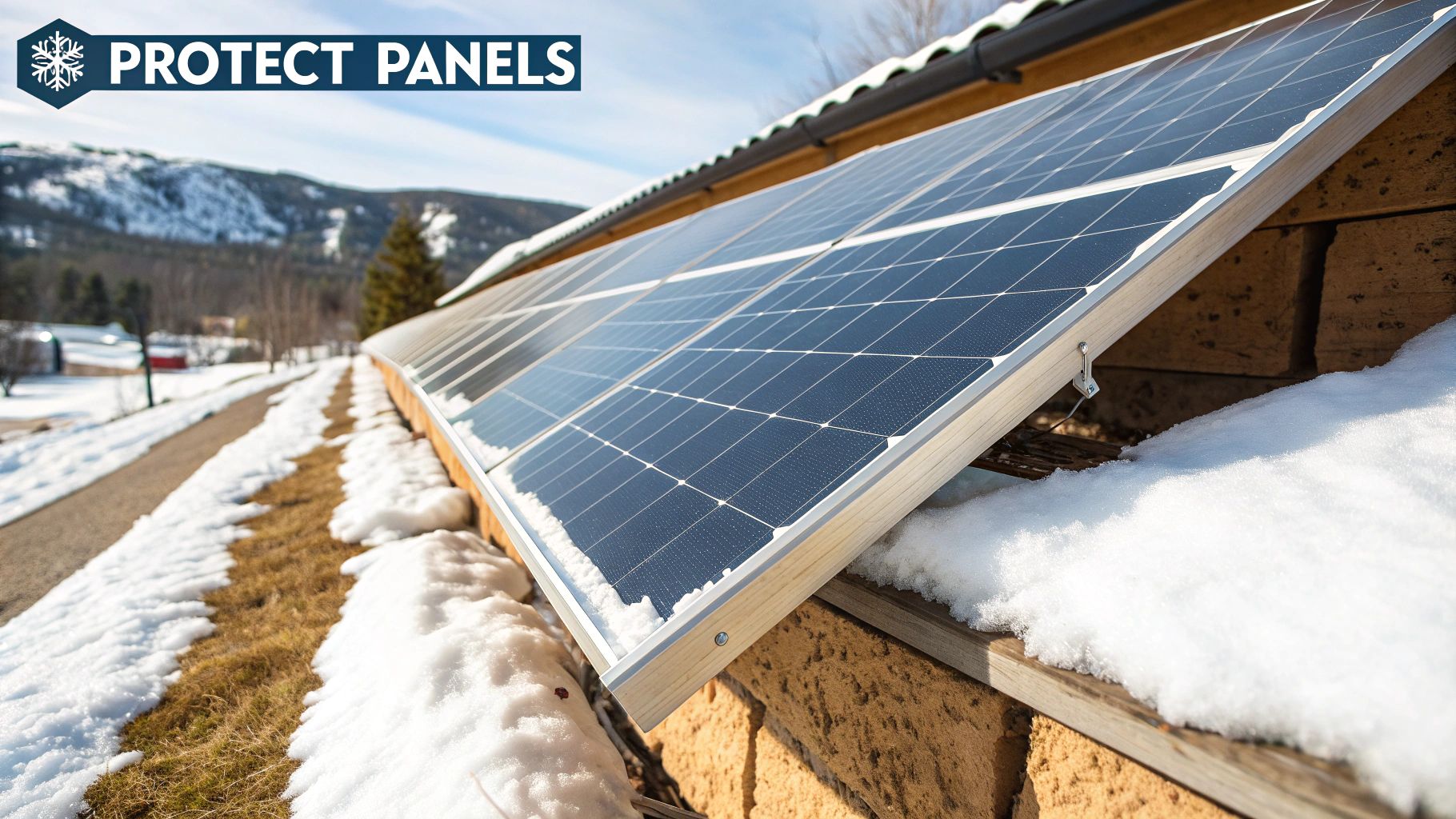
La mejor manera de hacer frente a la nieve en sus paneles solares es establecer un sistema que rara vez necesita limpieza en el primer lugar. En lugar de reaccionar a cada nevada, un poco de trabajo de diseño proactivo por adelantado puede ahorrarle un montón de dolores de cabeza invernales. Las decisiones que usted y su instalador tomen al principio influirán enormemente en la forma en que su sistema gestione la nieve.
Pensar en el futuro puede cambiar las cosas. No hay más que mirar a Alemania, un país con inviernos rigurosos que recibe unos 12% de su electricidad anual a partir de energía solar. Gran parte de su éxito se debe a un diseño inteligente del sistema que se anticipa a las condiciones meteorológicas.
Usted puede adoptar el mismo enfoque progresista para su propia casa y marcar una gran diferencia en su producción de energía en invierno.
El papel fundamental de la inclinación y orientación del panel
Una de las herramientas más poderosas de su arsenal es el ángulo de inclinación de sus paneles. Es simple física.
Cuando se instalan paneles con una inclinación mayor -idealmente 35 grados o más-dejas que la gravedad haga el trabajo pesado por ti. La nieve, especialmente la húmeda y pesada, tiene muchas más dificultades para adherirse y es mucho más probable que resbale.
La orientación también desempeña un papel importante. Un sistema orientado al sur es la mejor opción para captar la mayor cantidad de luz solar durante los cortos días de invierno. Esta exposición ayuda a calentar los paneles, lo que a su vez derrite la nieve y el hielo mucho más rápido. Combina una inclinación pronunciada con una orientación sur y habrás creado una potente máquina pasiva de limpieza de nieve.
Lo más importante: Un ángulo de inclinación más pronunciado es su mejor defensa contra la acumulación de nieve. Asegúrese de consultar con su instalador la inclinación óptima para su latitud y estructura de tejado específicas. antes de empiezan a trabajar.
Elegir el panel y los componentes del sistema adecuados
Más allá del ángulo y la dirección, lo que importa es el hardware. El diseño físico de los propios paneles solares puede ayudar o dificultar la retirada de la nieve.
Por ejemplo, he visto grandes resultados con módulos solares sin marco. Tienen una superficie de cristal lisa y continua. Esta sencilla característica de diseño elimina el borde metálico elevado que se encuentra en la mayoría de los paneles, un borde que actúa como una minipresa, atrapando la nieve y el hielo e impidiendo que el resto se deslice.
También se trata de los pequeños detalles. Asegúrese de que su sistema utiliza conectores fiables para paneles solares es crucial para la longevidad y la seguridad en condiciones climáticas adversas. Todos los componentes funcionan juntos. Si aún está en fase de planificación, nuestra guía sobre https://radiantenergysolar.com/how-to-choose-solar-panels/ puede ayudarle a elegir el mejor equipo para su clima.
Haciendo al instalador las preguntas adecuadas sobre inclinación, orientación y herrajes, puede construir un sistema solar realmente preparado para la nieve que siga produciendo durante todo el invierno con el mínimo esfuerzo.
Respuestas a sus preguntas sobre paneles solares para el invierno
Incluso con las mejores prácticas en la mano, es normal que todavía tenga algunas preguntas arremolinándose alrededor de sus paneles solares y la nieve. El invierno trae sus propias reglas, y saber qué esperar puede marcar una gran diferencia en la forma de gestionar el rendimiento de su sistema y cuidar de él a largo plazo.
Veamos algunas de las preguntas más frecuentes que me hacen los propietarios de viviendas cuando empiezan a caer los primeros copos. Estas respuestas aclararán cualquier confusión sobre lo que realmente ocurre en su tejado durante los meses más fríos.
¿Cuánta energía pierdo realmente por la capa de nieve?
Esta es la pregunta del millón y, sinceramente, la respuesta es: depende.
Una ligera y esponjosa capa de polvo sólo puede reducir su producción en un 30%. 10-30% durante un rato. ¿Pero una capa gruesa y pesada de nieve húmeda? Eso puede hacer que tu generación de energía se detenga por completo, provocando un colapso casi total de la red eléctrica. 100% pérdida hasta que finalmente se derrita o la elimines.
El verdadero impacto en su factura energética depende de cuántos días permanezcan cubiertos esos paneles. Si quieres entrar en el meollo del rendimiento estacional, tenemos una guía completa en cómo funcionan los paneles solares en invierno.
Información clave: No subestime el impacto de unos pocos días de nieve. Incluso un puñado de días con producción cero cada mes puede afectar a su ahorro energético y alargar la vida útil de su sistema. periodo de amortización de los paneles solares. Para cualquiera que viva en un clima nevado, éste es un factor importante en la ecuación financiera.
Para que te hagas una idea más clara, aquí tienes una idea aproximada de cómo esos días cubiertos de nieve empiezan a sumar en términos de pérdida de producción.
gantt
title Pérdida potencial de producción solar mensual debida a la capa de nieve
dateFormat X
axisFormat %s
sección 3 Días cubiertos
Pérdida de producción :0, 10
sección 7 Días Cubiertos
Pérdida de Producción :0, 23
sección 14 Días cubiertos
Pérdida de producción :0, 47
sección 21 Días cubiertos
Pérdida de producción :0, 70
sección 30 Días Cubiertos
Pérdida de Producción :0, 100
El gráfico muestra la pérdida de producción estimada en porcentaje para un periodo de 30 días.
Como puedes ver, las pérdidas se acumulan rápidamente. Es un duro recordatorio de por qué es tan importante aprender a despejarlas con seguridad si la nieve decide quedarse.
¿Puede la nieve intensa dañar mis paneles?
Es una buena pregunta, pero la buena noticia es que probablemente no. Los paneles solares están diseñados para ser increíblemente resistentes. Se someten a duras pruebas de presión para garantizar que pueden soportar el peso de la nieve densa y pesada. La mayoría están preparados para soportar varios metros de acumulación sin sudar.
La pieza más importante del rompecabezas es la propia instalación. Una instalación profesional de calidad garantiza la seguridad de las estanterías y, lo que es igual de importante, que el tejado pueda soportar el peso combinado de los paneles. y una gran carga de nieve. Una instalación sólida como una roca es su mejor defensa contra cualquier problema relacionado con el peso.
¿Quitar la nieve yo mismo anula la garantía?
Presta mucha atención a esta pregunta, porque la respuesta es un gran y rotundo Sí, puede.
La garantía de su panel solar cubre los defectos de fabricación, no los daños causados por accidente. Coger la herramienta equivocada es la forma más rápida de encontrarse con una garantía anulada. Si raspas el revestimiento antirreflectante con una pala metálica o creas microgrietas golpeando el panel, puedes estar seguro de que el fabricante no lo cubrirá.
Para mantener su garantía a salvo, siga estas sencillas normas:
- Siempre utilice una herramienta diseñada específicamente para este trabajo, como un rastrillo de nieve de espuma blanda o con cabeza de goma.
- Nunca deje que se acerquen a sus paneles objetos afilados, plásticos duros, metal o cualquier tipo de descongelante químico.
- Stick a los métodos seguros de eliminación en tierra que ya hemos cubierto.
Respetar las normas del fabricante es la única forma de proteger su inversión a largo plazo.
En Energía radiantediseñamos e instalamos sistemas solares construidos para soportar los inviernos más duros. Si usted está listo para una solución solar resistente que maximiza su producción de energía durante todo el año, póngase en contacto con nosotros para una consulta gratuita en. https://radiantenergysolar.com.

